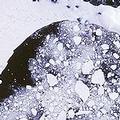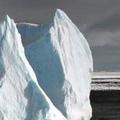 據一份與英德科學家共同合作發表的美國地質調查局(USGS)報告指出,南極洲已有一座冰架完全融化,而另一座冰架已損失約羅德島州3倍大的冰體(約8500餘平方公里,略小於1/4台灣島面積)。
據一份與英德科學家共同合作發表的美國地質調查局(USGS)報告指出,南極洲已有一座冰架完全融化,而另一座冰架已損失約羅德島州3倍大的冰體(約8500餘平方公里,略小於1/4台灣島面積)。
美國地質調查局的研究集中在南極洲,該地區是地球最大的冰河區。該報告指出,南極洲的冰河因氣候變遷正以比先前所知更快的速度融解中。美國內政部長沙拉薩(Ken Salazar)說:「這項研究對南極洲沿岸和冰河變化範圍提供最直接的探討依據。當地冰河迅速消退,再一次證明我們的地球已深深地、且更迅速地經歷氣候變遷所帶來的效應。」「美國地質調查局的科學工作,正調查氣候變遷對全世界的影響,其中包括對冰河的檢測,這將是歐巴馬政府承諾對抗氣候變遷的關鍵基礎。」
使用歷史資料和新拍攝的衛星圖像、空中攝影、其他數據, 和最新的製圖技術,美國地質調查局4月3日發布的研究,沿著南極洲的拉森(Larsen)和沃迪(Wordie)冰架描繪冰河消退的軌跡。
科學家先前就已知沃迪冰架消退的情形,但這次研究是第一次記錄該冰架已完全消失的情形。此外,拉森冰架的北部也不復存在。從1986年至今起,從拉森冰架崩離的冰體已超過羅德島州大小3 倍,達8500餘平方公里面積。
地質調查局科學家報告說,這些浮動冰架對氣候變遷特別敏感,它們迅速的消退可能是項警訊,意味著南極洲的陸上冰原也將因氣候暖化而不斷流失。
科學家們警告,這可能導致海平面上升、威脅在地處低窪的沿岸社區和島嶼,地質調查局研究報告的首席作者、地質學家費里格諾(Jane Ferrigno)說:「持續且顯著的冰河消退正警告我們地球系統正在改變,我們必須預作準備。南極洲擁有全球約91%的冰河,因此特別值得關注,在冰原上的任何改變均會對人類社會帶來嚴重的威脅。」
關於拉森冰架的新報告和地圖是研究整個南極洲海岸的沿岸變化和冰河特性的一部分。研究也是美國地質調查局冰河研究計畫的一部份,該計畫使用衛星圖像監控並描繪地球上冰河的範圍和變化。
 在4月3日出版於地球物理研究通訊(Geophysical Letters)的另一項研究中,國家海洋暨大氣總署(NOAA)報告指出,北極圈的夏天將於30年內達到無冰狀態,與上世紀所預測的情形不同。
在4月3日出版於地球物理研究通訊(Geophysical Letters)的另一項研究中,國家海洋暨大氣總署(NOAA)報告指出,北極圈的夏天將於30年內達到無冰狀態,與上世紀所預測的情形不同。
「北極正以比預期更快的速度改變。這是自然變化、空氣暖化,和溫室氣體造成的海洋條件結合而成。」NOAA太平洋海洋環境實驗室海洋學家,也是該研究的合著者歐凡藍登(James Overland)如此表示。
夏天海冰覆蓋的地區預計減少至目前面積的1/4,自目前180萬平方英里(約466萬平方公里)減少至約39萬平方英里(約100萬平方公里), 約損失2/5美國大陸面積。NOAA團隊預言,在加拿大和格陵蘭北邊的海冰將能維持現狀,但在太平洋北極區的阿拉斯加和俄羅斯將會減少。
One Antarctic ice shelf has completely disappeared and another has lost a chunk three times the size of Rhode Island, according to a new U.S. Geological Survey report prepared in collaboration with British and German scientists.
The USGS study focuses on Antarctica, the Earth's largest reservoir of glacial ice. It shows that Antarctica's glaciers are melting more rapidly than previously known because of climate change.
"This study provides the first insight into the extent of Antarctica's coastal and glacier change," said U.S. Interior Secretary Ken Salazar. "The rapid retreat of glaciers there demonstrates once again the profound effects our planet is already experiencing ?more rapidly than previously known - as a consequence of climate change."
"The scientific work of USGS, which is investigating the impacts of climate change around the world, including an ongoing examination of glaciers, is a critical foundation of the administration's commitment to combat climate change," Salazar said.
Using historical and recent satellite imagery, aerial photography and other data, as well as the newest mapping techniques, the USGS study released today maps recent glacier retreat along Antarctica's Larsen and Wordie Ice Shelves.
Scientists previously knew that the Wordie Ice Shelf has been retreating, but this study documents for the first time that it has completely disappeared.
Moreover, the northern part of the Larsen Ice Shelf no longer exists. An area more than three times the size of the State of Rhode Island - more than 8,500 square kilometers - has broken off from the Larsen Ice Shelf since 1986.
USGS scientists report that these floating ice shelves are especially sensitive to climate change, so their rapid retreat may be a forecast for losses of the land-based ice sheet on the Antarctic continent if warming continues.
This could result in sea-level rise, threatening low-lying coastal communities and islands, they warn.
"This continued and often significant glacier retreat is a wakeup call that change is happening in our Earth System and we need to be prepared," said USGS glaciologist Jane Ferrigno, lead author on the study. "Antarctica is of special interest because it holds an estimated 91 percent of the Earth's glacier volume, and change anywhere in the ice sheet poses significant hazards to society."
The new report and map of the Larsen Ice Shelf are part of a project to research the coastal change and glaciological characteristics of the entire Antarctic coastline.
The research is also part of the USGS Glacier Studies Project that is monitoring and describing glacier extent and change over the whole planet using satellite imagery.
In a separate study published in today's issue of the journal "Geophysical Letters," the National Oceanic and Atmospheric Administration reports that summers in the Arctic may be ice-free in as few as 30 years, not at the end of the century as previously expected.
"The Arctic is changing faster than anticipated," said James Overland, an oceanographer at NOAA's Pacific Marine Environmental Laboratory and co-author of the study. "It's a combination of natural variability, along with warmer air and sea conditions caused by increased greenhouse gases."
The area covered by summer sea ice is expected to decline to about one-quarter of its present size - from its current 1.8 million square miles to about 390,000 square miles - a loss of two-fifths the size of the continental United States.
The NOAA team predicts that much of the sea ice would remain in the area north of Canada and Greenland and decrease between Alaska and Russia in the Pacific Arctic.






